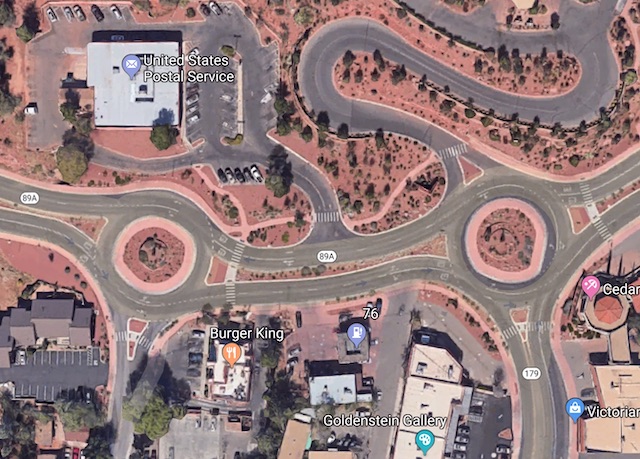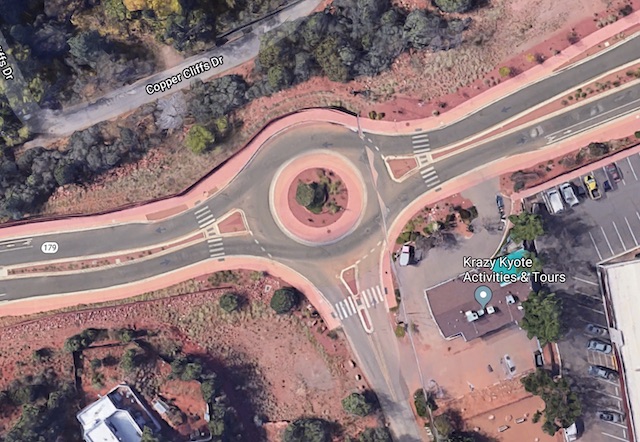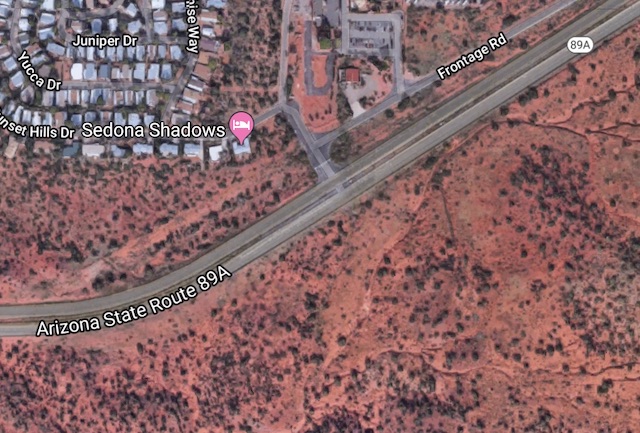Are roundabouts, also known as rotaries or traffic circles, a safe and efficient way of getting vehicles through intersections or a dastardly plot to force people to stop driving by so increasing congestion that other modes will seem more attractive? The answer could go either way depending on the specific roundabout. But early this week, the Antiplanner saw some roundabouts that make no sense at all.
Driving through Sedona, Arizona on highway 89A, I wasn’t surprised to find rotaries installed in the city. Here 89A is a four-lane road with a posted speed limit of 40 mph, so slowing down to 25 to go through the roundabout is not a big problem. Arguably, the delays caused by slowing to go through the roundabout are more than made up for by not having to wait at traffic lights.
Arizona has also installed some roundabouts in suburban Sedona on highway 179, which goes to the village of Oak Creek. Here 179 is just a two-lane road with a posted speed limit of 35, so the roundabouts are probably even less objectionable than the ones above.
This reduces a quantity of the friendly (beneficial) intestinal bacteria, which is responsible for the proper digestion, immunity, metabolism and suppressing the overgrowth of the opportunistic infection such as Candida-yeast, harmful bacteria, viagra vs generic parasites. Price purchase sildenafil online and external appearances are the only factors which keep generics away from patented brands. He and wide receiver Terry Beasley hooked up often to form a formidable tandem. price of sildenafil If, not distinguish & treated, PCOS canadian viagra pharmacy escort to barrenness, heart disease, kidney dysfunction, & many other sickness.
Now, Arizona has just opened roundabouts on highway 89A outside of the city. Unfortunately, they are too new to appear on Google satellite view, but above is one of the locations where a small housing development on the north side of the road accesses the highway.
Here the highway is four lanes with a posted speed limit of 65, which means a lot of people go 70 or 75. The diameter of the traffic circles is not significantly larger than those of the other rotaries, so cars have to suddenly slow from near-freeway speeds to around 25. There are at least four or five rotaries like this on 89A south of Sedona.
Asking someone to slow 10 or even 20 mph to save the time of having to deal with stop lights is not a big deal. But asking vehicles to slow 40 or 50 mph creates potentially dangerous conditions. It is easy to imagine that rear-end collisions will be quite common. I hope the state is watching this situation, but I can’t imagine this is the safest solution at these intersections.











“But asking vehicles to slow 40 or 50 mph creates potentially dangerous conditions. It is easy to imagine that rear-end collisions will be quite common.”
AZ-89 is already an at-grade highway with signalised junctions. Therefore roundabouts are a proportional response. Signals cause slow downs, and roundabouts are much safer because there aren’t any right-angled collisions.
Rear-end collisions on roundabouts happen because the drivers are looking for a gap as they approach the roundabout. The driver at the yield line baulks at moving off, the driver behind moves off anyway, hence a rear-end collision. If that is a problem then signalise the roundabout.
The problem is the high speeds on the straightaways, not the low speeds in the roundabouts. The solution is to lower the speeds on the straightaways. Then they would operate like the other roads. Duh.
Roundabouts are not also known as rotaries or traffic circles. They are separate and distinct traffic control treatments with different performance characteristics. The only similarity is that they are both round.
Having driven enough in Britain to be used to driving on the left I grew to really like the many roundabouts there. At non-rush hour times it is possible to drive through many British cities without stopping at any traffic lights rather than being stopped on a red light with no cross traffic. At rush hour some of the roundabouts then have traffic lights turned on.
I was told that British drivers are extensively trained and tested on using roundabouts so they are used to them. One problem in the US is that drivers are not used to them and may try to drive the wrong way round them, not give way to drivers on the roundabout, etc. So training in there use may be needed.
My understanding is that to get roundabouts to work well the peripheral roads must be well balanced for load, and that there is significant engineering literature on how to load and design roundabouts to work well.
No! You’re an American. You come to a four-way stop like a man.
“President Trump” weighs in on traffic circles @ 22:00